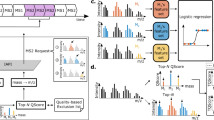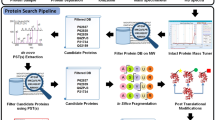Abstract
Current non-gel techniques for analyzing proteomes rely heavily on mass spectrometric analysis of enzymatically digested protein mixtures. Prior to analysis, a highly complex peptide mixture is either separated on a multidimensional chromatographic system1,2 or it is first reduced in complexity by isolating sets of representative peptides3,4,5,6,7,8. Recently, we developed a peptide isolation procedure based on diagonal electrophoresis9 and diagonal chromatography10. We call it combined fractional diagonal chromatography (COFRADIC). In previous experiments, we used COFRADIC to identify more than 800 Escherichia coli proteins by tandem mass spectrometric (MS/MS) analysis of isolated methionine-containing peptides11. Here, we describe a diagonal method to isolate N-terminal peptides. This reduces the complexity of the peptide sample, because each protein has one N terminus and is thus represented by only one peptide. In this new procedure, free amino groups in proteins are first blocked by acetylation12 and then digested with trypsin. After reverse-phase (RP) chromatographic fractionation of the generated peptide mixture, internal peptides are blocked using 2,4,6-trinitrobenzenesulfonic acid (TNBS)13,14; they display a strong hydrophobic shift and therefore segregate from the unaltered N-terminal peptides during a second identical separation step. N-terminal peptides can thereby be specifically collected for further liquid chromatography (LC)-MS/MS analysis. Omitting the acetylation step results in the isolation of non-lysine-containing N-terminal peptides from in vivo blocked proteins.
This is a preview of subscription content, access via your institution
Access options
Subscribe to this journal
Receive 12 print issues and online access
$209.00 per year
only $17.42 per issue
Buy this article
- Purchase on Springer Link
- Instant access to full article PDF
Prices may be subject to local taxes which are calculated during checkout



Similar content being viewed by others
Accession codes
References
Shen, Y. et al. High-throughput proteomics using high-efficiency multiple-capillary liquid chromatography with on-line high-performance ESI FTICR mass spectrometry. Anal. Chem. 73, 3011–3021 (2001).
Washburn, M.P., Wolters, D. & Yates III, J.R. Large-scale analysis of the yeast proteome by multidimensional protein identification technology. Nat. Biotechnol. 19, 242–248 (2001).
Gygi, S.P. et al. Quantitative analysis of complex protein mixtures using isotope-coded affinity tags. Nat. Biotechnol. 17, 994–999 (1999).
Geng, M., Ji, J. & Regnier, F.E. Signature-peptide approach to detecting proteins in complex mixtures. J. Chromatogr. A. 870, 295–313 (2000).
Oda, Y., Nagasu, T. & Chait, B.T. Enrichment analysis of phosphorylated proteins as a tool for probing the phosphoproteome. Nat. Biotechnol. 19, 379–382 (2001).
Wang, S. & Regnier, F.E. Proteomics based on selecting and quantifying cysteine-containing peptides by covalent chromatography. J. Chromatogr. A. 924, 345–357 (2001).
Zhou, H., Watts, J.D. & Aebersold, R. A systematic approach to the analysis of protein phosphorylation. Nat. Biotechnol. 19, 375–378 (2001).
Zhou, H., Ranish, J.A., Watts, J.D. & Aebersold, R. Quantitative proteome analysis by solid-phase isotope tagging and mass spectrometry. Nat. Biotechnol. 20, 512–515 (2002).
Brown, J.R. & Hartley, B.S. Location of disulphide bridges by diagonal paper electrophoresis. The disulphide bridges of bovine chymotrypsinogen A. Biochem. J. 101, 214–228 (1966).
Cruickshank, W.H., Malchy, B.L. & Kaplan, H. Diagonal chromatography for the selective purification of tyrosyl peptides. Can. J. Biochem. 52, 1013–1017 (1974).
Gevaert, K. et al. Chromatographic isolation of methionine-containing peptides for gel-free proteome analysis: identification of more than 800 Escherichia coli proteins. Mol. Cell. Proteomics 1, 896–903 (2002).
Yumoto, N. & Tokushige, M. Acetylation-induced alteration of catalytic and regulatory properties of aspartase. Biochim. Biophys. Acta 749, 101–115 (1983).
Okuyama, T. & Satake, K. On the preparation and properties of 2,4,6-trinitrophenyl-amino acids and –peptides. J. Biochem. (Tokyo) 47, 454 (1960).
Fields, R. The rapid determination of amino groups with TNBS. Methods Enzymol. 25, 464–468 (1972).
Fox, J.E. Identification of actin-binding protein as the protein linking the membrane skeleton to glycoproteins on platelet plasma membranes. J. Biol. Chem. 260, 11970–11977 (1985).
Perkins, D.N., Pappin, D.J., Creasy, D.M. & Cottrell, J.S. Probability-based protein identification by searching sequence databases using mass spectrometry data. Electrophoresis 20, 3551–3567 (1999).
O'Connor, P.B. & Costello, C.E. Internal calibration on adjacent samples (InCAS) with Fourier transform mass spectrometry. Anal. Chem. 72, 5881–5885 (2000).
Acknowledgements
K.G. is a postdoctoral fellow and L.M. a research assistant of the Fund for Scientific Research–Flanders (Belgium) (F.W.O.–Vlaanderen). The project was further supported by the Concerted Research Actions (GOA) of the Flemish Community, the Inter University Attraction Poles (IUAP), and the GBOU-research initiative of the Flanders Institute of Science and Technology (IWT).
Author information
Authors and Affiliations
Corresponding author
Ethics declarations
Competing interests
The authors declare no competing financial interests.
Supplementary information
Rights and permissions
About this article
Cite this article
Gevaert, K., Goethals, M., Martens, L. et al. Exploring proteomes and analyzing protein processing by mass spectrometric identification of sorted N-terminal peptides. Nat Biotechnol 21, 566–569 (2003). https://doi.org/10.1038/nbt810
Received:
Accepted:
Published:
Issue Date:
DOI: https://doi.org/10.1038/nbt810
This article is cited by
-
Proteomic data and structure analysis combined reveal interplay of structural rigidity and flexibility on selectivity of cysteine cathepsins
Communications Biology (2023)
-
Characterising proteolysis during SARS-CoV-2 infection identifies viral cleavage sites and cellular targets with therapeutic potential
Nature Communications (2021)
-
Proteolysis and inflammation of the kidney glomerulus
Cell and Tissue Research (2021)
-
Spatially Resolved Tagging of Proteolytic Neo-N termini with Subtiligase-TM
The Journal of Membrane Biology (2021)
-
Analysis of complement deposition and processing on Chlamydia trachomatis
Medical Microbiology and Immunology (2021)



